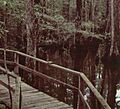List of National Natural Landmarks in South Carolina facts for kids
South Carolina is home to six amazing places called National Natural Landmarks. These special spots are recognized for their unique natural features. They help us understand and protect important parts of our planet's history and nature.
Contents
South Carolina's Natural Wonders
South Carolina has many beautiful and important natural areas. Six of these have been given the special title of "National Natural Landmark." This means they are some of the best examples of natural features in the entire United States. They show us different kinds of forests, rocks, and islands, and are home to many plants and animals.
Congaree River Swamp
The Congaree River Swamp was named a National Natural Landmark in May 1974. You can find it near Columbia in Richland County. This huge area is a federal property and is part of Congaree National Park.
It's one of the biggest and oldest cypress-gum swamps and hardwood forests in South Carolina. Imagine towering trees and a rich environment perfect for all kinds of wildlife. It's a truly wild and ancient place.
Flat Creek Natural Area and 40 Acre Rock
Designated in August 1984, the Flat Creek Natural Area and 40 Acre Rock are located near Kershaw in Lancaster County. This area is owned by the state and is part of the 40 Acre Rock Heritage Preserve.
This landmark features the largest untouched granite rock outcrop in the Carolina Piedmont region. It's like a giant, flat rock surface with special plants growing on it. Some of these plants are very rare or only found in this area. There's also a very thick rock formation called the Flat Creek Dike, which is one of the thickest in eastern North America.
Francis Beidler Forest
The Francis Beidler Forest became a National Natural Landmark in March 1979. It's located near Harleyville, stretching across Berkeley and Dorchester counties. This forest is privately owned.
It is one of the last large, untouched bald cypress-tupelo gum swamps in the United States. This means the trees here are very old and have never been cut down. The forest has five main types of natural communities, which means it has a huge variety of different plants and animals living there.
John de la Howe Forest
Named a National Natural Landmark in January 1976, the John de la Howe Forest is found near McCormick in McCormick County. This forest is owned by the state.
This is an old-growth forest of oak and pine trees. What makes it special is that it has been protected from fires and logging since 1797! This makes it one of the best examples of this type of forest left in the Piedmont region. It's like a living history book of what forests used to be like.
St. Phillips Island
St. Phillips Island was designated a National Natural Landmark in May 1986. It's located near Beaufort in Beaufort County and is privately owned.
This barrier island is about 4 miles (6.4 km) long and 2 miles (3.2 km) wide. It's very special because it's almost completely untouched by human development. Most barrier islands have houses or roads, but St. Phillips Island is still wild. It also has unique sand dunes with lots of plants, which are rare to see along the Atlantic Coast.
Stevens Creek Natural Area
The Stevens Creek Natural Area became a National Natural Landmark in March 1979. It's located near Plum Branch in McCormick County and is owned by the state. It's part of the Stevens Creek Heritage Preserve.
This area is a "relict ecosystem" from the Pleistocene era, which was a very long time ago. It has a unique mix of plants that are unusual for this southern location. This is because of special microclimates, which are tiny areas with different weather conditions. It's like a little pocket of a different time, preserved in nature.
Images for kids







